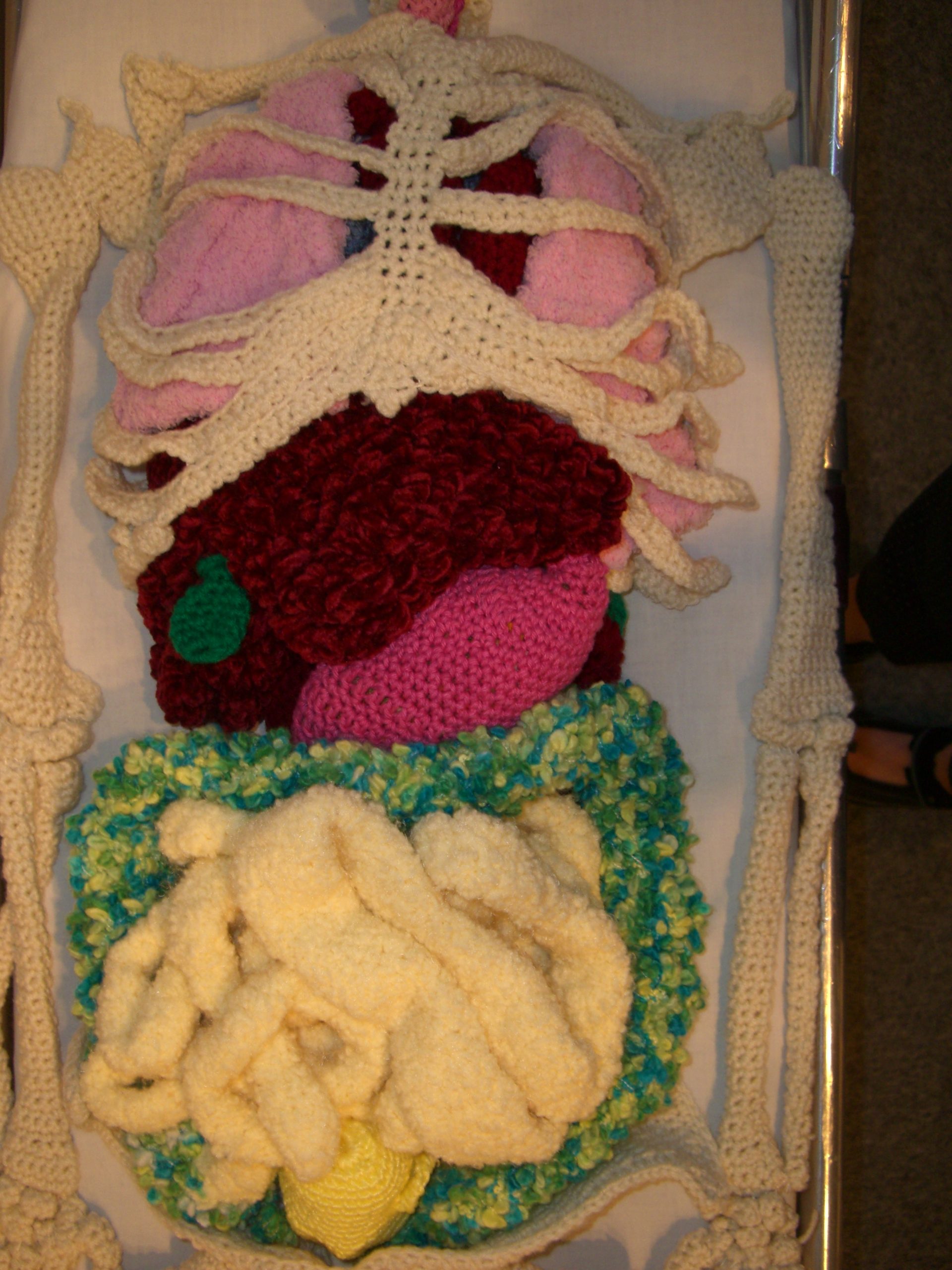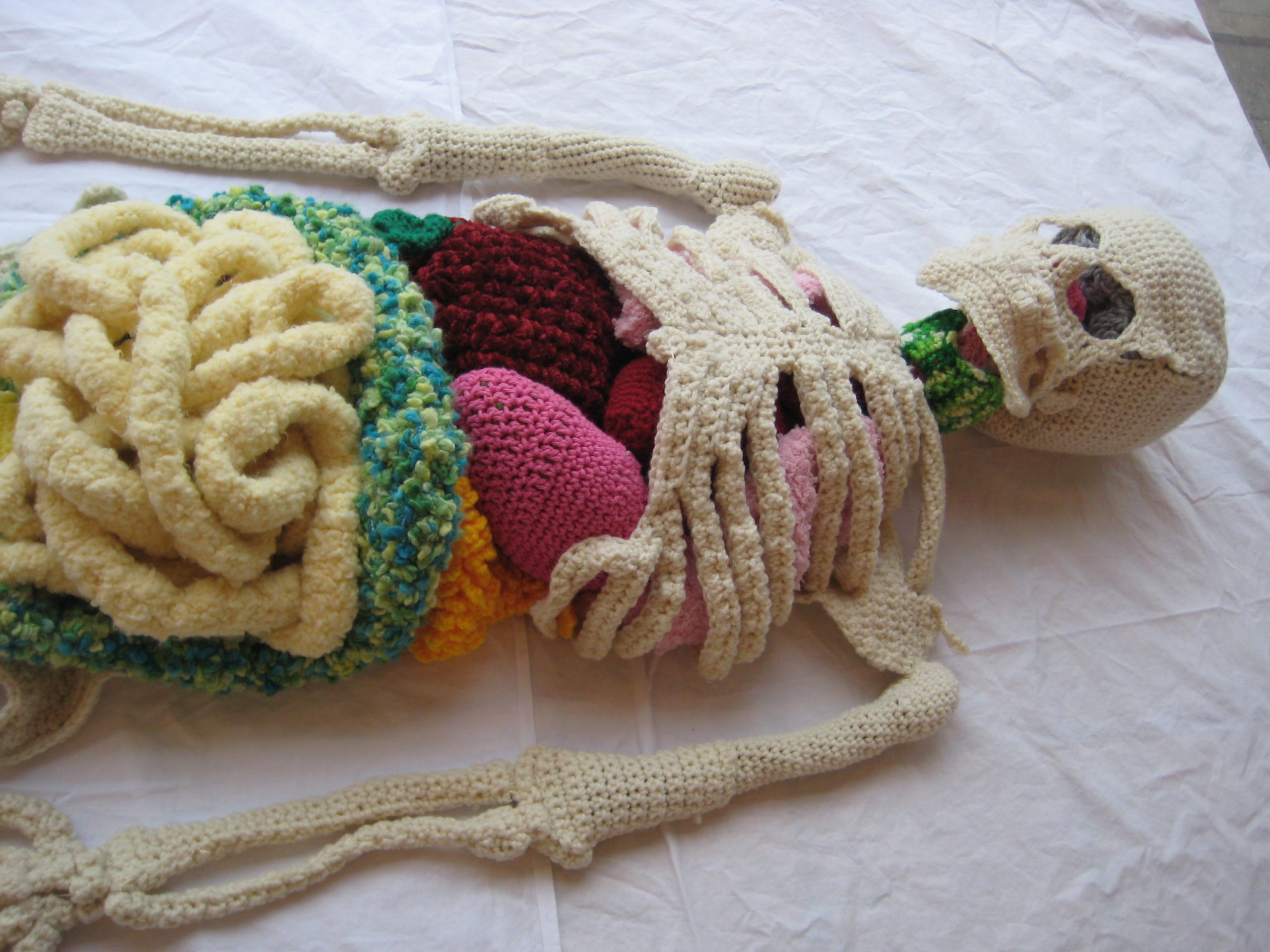You guys LOVE totally grotesque things rendered in fluffy yarn form. I’ve seen those “likes” on the Facebook page. Don’t try to lie to me about this.
I sought out artist Shanell Papp, who created this full-scale anatomical skeletal/organ model below, to ask her some questions about this massive undertaking.
People who follow the Order love (like seriously, love) knit corpses, knit anatomicals, knit dissected-animal carcasses. What is the appeal, do you think?
I know I am pretty excited when people love the work, I have a wide spectrum of admirers from gore hounds to art galleries to textile aficionados. The greatest part of the work is that it is a conversation starter, it gets people to comfortably talk about uncomfortable subjects. It is really great to watch people talk about the work, I sometimes pretend like I didn’t make it…..they always wanna put their hand into the intestines, it is very strange, like some kind of a dissection urge?!
Some see it as a playful and jokey piece….but when I made it I was pretty serious about making a very exacting replica of the human body. There are parts of the work that nobody sees–the brain has gray and white matter, the bones have marrow, the stomach has half digested food in it. I made it to understand my body better and I think this is why people like it. They want to talk about the heavy stuff, but nobody seems like they want to listen. It is an invitation to unburden themselves, I think.
 Is the grotesque somehow easier for us to take when it’s snuggly?
Is the grotesque somehow easier for us to take when it’s snuggly?
YES! I think the snuggliness somehow removes the feeling of pure terror. I lived on a farm for a few years years from age 11-14, after only growing up in the city. At this point I had a developing interest in death, and the lives of animals on farms are pretty cheap…..their biology is harnessed for production and they die horribly. I remember one day in particular, where I helped kill 100+ chickens. It was horrible…especially horrible since after the chickens heads were chopped off they were flung into the air, so they would bounce and flip around. We had to eviscerate the carcasses. This was actually pretty horrible….so I think knit organs are way nicer! Additionally, did you know that chickens can still make noise after they lose their heads?
How long did the Lab piece (the anatomical skeleton) take you from conception to debut?
I thought about the work for awhile before making it. I made Body first, in 2005, which was interested in dissecting my identity; this work took about four months to make.
After Body, I Immediately started to make LAB (skeleton) It took me about 4 months to make the skeleton and another 4 months to make the internal organs…..I also gave up any idea of a “normal” social life and I pretty much dedicated myself to the task, between classes and work of course.
To make the work, I borrowed a human skeleton from the university and collected anatomical textbooks. I also managed to track down a mortuary gurney for displaying the work–a mortuary gave me a gurney after a renovation…they were looking to get rid of it since “people are were getting too fat for the gurney.” I also worked in an old hospital turned history museum. I also went to open house day at a local funeral…they gave me a decorative pen. During my graduate studies, I was granted open access to the gross anatomy lab, though I was long finished making LAB/skeleton at this point. I was given access to draw, look around…. It is always funny how specimens are collected and cared for.
People sort of know me as the right person to give odd items to…old medical books, X-rays, old photos, Victorian taxidermy for children, mannequins, etc.
You mentioned that it was, in a way, an exercise about contemplating mortality?
The work is a bit macabre. It is definitely about my interest in death. I became interested in medical history in the late teens and I was considering becoming a radiologist for awhile. So my interest in death, medicine and horror collided. I became fascinated by the enlightenment, medical history and Frankenstein. I was raised in a house free from any religious trappings, so I had no conception of an afterlife. So I was very interested in how a body works and the history of medicine. As I made the work I thought, what does a liver do? What does a heart do? It was about taking the time to build the body and to think about the body…. I often compared parts of the body to my own body.
Cuevas’ piece
Ben Cuevas–idea stealer or skeleton knitter colleague?
I don’t know…but what I do know it that it is hard to make a skeleton and it takes a certain kind of patience and skill, that I think this is pretty uncommon in the Internet/cell phone era, so I think we must be part of some secret club.
I think Cuevas made his work for different reasons than I did. It seems spiritual/heath-related, since the skeleton is meditating on a pyramid of canned milk. Though we are not the only ones making yarn skeletons.
 Find Shanell here as well.
Find Shanell here as well.




